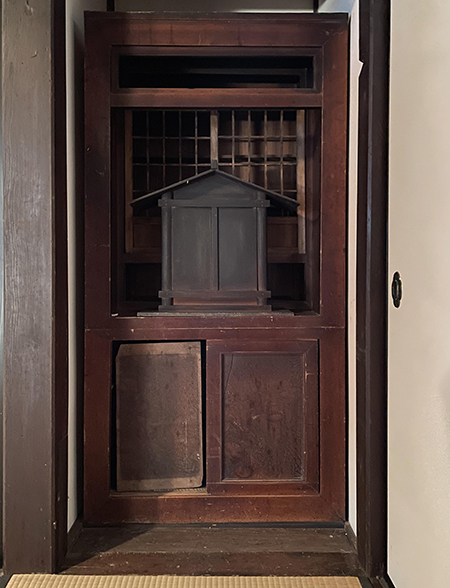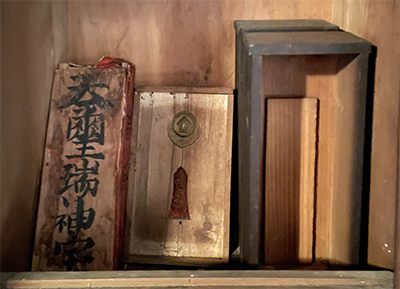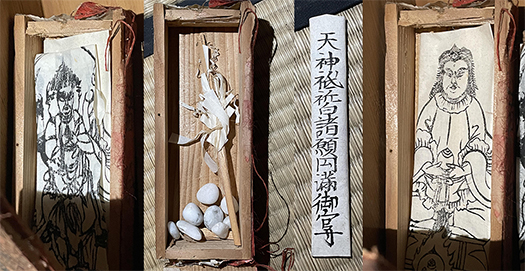


紹介している旧立川番所書院は、管理の委託を県から受けた周辺住民のみなさんが交代で管理されています。こういう形式はほかの地域、知りうる範囲では奈良県の古格な建築施設などでも見られました。管理と見学のバランス、その行政コストバランスを考えれば、合理的な手法だと思います。
そもそもこの建物は明治維新によって藩が県に代わって、それまでは藩士の内、この職に携わっていた氏族がそのまま建築主として継続した経緯のようなのです。熱心に建物のことを説明していただけ、いろいろな経緯由来を説明の方にたくさん伺わせていただいていました。
そのことがたまたま写真の仏壇のような部位の説明時に盛り上がって「このイレモノの中身を改めていただきたい」という思わぬ申し出を受けてしまった。古色蒼然とした「古文書類」然とした雰囲気から、管理人としても、申し送り事項かとしても中身の確認にまで及んでいなかったのだというのです。
そういうことなので禁忌的な「触らぬ神に祟りなし」みたいな秘密の存在になってしまっているということ。で、熱心に建物やその来歴を質問する「男性」としてわたしは見込まれてしまい(笑)「こういう秘物には男性しかさわるべきではない」みたいな素朴な信心に基づかれて、わたしにそういう願いが託された。・・・これは謹んで役目を承るしかない。
で、さわる前に十分に般若心経を唱えさせていただいた後、古文書類を検分させていただいた。万が一祟りを受けることになっても、般若心経は東アジア世界に普遍的な経文であり、なお北海道人ならばそれほど大事にはならないだろうという管理者としての判断か(笑)。
復元可能なように慎重に古文書類を開いて行ってたどりついた解明結果が3枚目の写真。江戸期を通じてこの建築の管理を委託されていた家系のお位牌などではなく、金比羅さんと出雲大社参詣のときの参拝記念物・ 護摩符類が奉納されていたことがわかった次第。
江戸期にはこの建物の所有形態は藩の所有物であり、そういう役儀から参勤交代時の「寄り道」として藩主などがこれらの神社仏閣を訪ね歩き、その随行目的で同行した際にもとめた参拝記念品だと思われた。格別感のある品々であり購入者は藩主クラスと思える。雰囲気からはそういった経緯が感じられた。それぞれの護摩府は厳重に箱入りになっていて、この建物の役儀にとってもふさわしい収納品と認識していたと思われる。ただ単に個人的旅行でここまで厳重に保管される可能性は薄い。
たぶんそういった記念品を、土佐の「玄関口」であるこの建物に保守させておくのが土佐藩としての判断だったように思える。一応、以上が現認した実感も込めた背景事情ではと思っています。
この探索の旅から数ヶ月が経過しておりますが、特段の「祟り」はなくきわめて健康に過ごさせていただいております。むしろさまざまな「御利益」があったかも(笑)。
English version⬇
The Family and the “Spirituality” of Old Documents, Tosa Clan, Former Tachikawa Bansho Shoin-5
I was unexpectedly asked to take on the task of searching for old documents. When he disclosed the carefully packaged items in storage, he came across secret items that appeared to be gomabu (prayer charms) from Izumo and Kompira. The…
The former Tachikawa Bansho Shoin introduced here is managed by local residents who are entrusted by the prefecture to take turns managing the building. This type of management has been seen in other areas and, to the best of my knowledge, also in Nara Prefecture’s old architectural facilities. Considering the balance between management and tours, as well as the administrative costs involved, I think this is a reasonable approach.
The building was originally built by a clan that had been involved in the construction of this building until the Meiji Restoration, when the clan was replaced by the prefecture, and the family members who had been involved in the construction of the building continued to serve as the owners. The explanation was given enthusiastically, and I was able to ask many questions about the history and origin of the building.
This happened to be enlivened during the explanation of parts such as the Buddhist altar in the photo, and I received an unexpected offer to “please modify the contents of this iremono. The atmosphere of the room was so old-fashioned and “antiquarian” that the manager had not even checked the contents of the room, even though it was a matter of arrangement.
Therefore, it has become a kind of secret existence, as if it were a taboo subject. I was expected to be a “man” who would eagerly ask questions about the building and its history (laugh), and based on a simple belief that “only men should touch such a secret object,” such a wish was entrusted to me. I had no choice but to accept the request respectfully.
So, after chanting the Heart Sutra before touching it, I inspected the ancient documents. I guess it was the administrator’s judgment that even in the unlikely event of possession, the Heart Sutra is a universal scripture in East Asia, and that it would not be so important to a Hokkaido person (laugh).
The third photo is the result of the careful search of old documents for possible restoration. It turns out that the tablets were not from the family that had been entrusted with the management of this building throughout the Edo period, but memorials and votive tablets that had been dedicated during pilgrimages to Kompira-san and Izumo-taisha Shrine.
In the Edo period, this building was owned by the feudal domain, and it is thought that these were souvenirs of visits to these shrines and temples by feudal lords as a “side trip” on their way to the shrines and temples, and for the purpose of accompanying them. The items have a sense of prestige, and the purchasers seem to have been of the clan lord class. The atmosphere of the place gave the impression of such a background. Each gomafu was boxed up tightly, and it is thought that the officials of this building recognized it as an appropriate storage item. It is unlikely that they would have been stored so securely simply for a personal trip.
It seems that the Tosa Clan probably decided to keep such mementos in this building, which is the “gateway” to Tosa. I believe these are the background circumstances that I have observed and felt.
A few months have passed since my search, and I have not experienced any particular “haunting” and have been spending my time in extremely good health. In fact, I may have received various “blessings” (laugh).
Posted on 4月 24th, 2023 by 三木 奎吾
Filed under: 住宅取材&ウラ話, 歴史探訪







コメントを投稿
「※誹謗中傷や、悪意のある書き込み、営利目的などのコメントを防ぐために、投稿された全てのコメントは一時的に保留されますのでご了承ください。」
You must be logged in to post a comment.